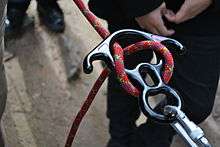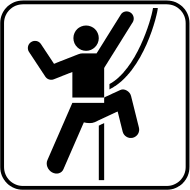Abseiling

An abseil (/ˈæbseɪl/ or /ˈɑːpzaɪl/; from German abseilen, meaning "to rope down"), also called a rappel after its French name, is a controlled descent of a vertical drop, such as a rock face, using a rope.
Climbers use this technique when a cliff or slope is too steep and/or dangerous to descend without protection. Many climbers use this technique to protect established anchors from damage. Rope access technicians also use this as a method to access difficult-to-reach areas from above for various industrial applications like maintenance, construction, inspection and welding. Rescue teams are also known for using this method as a way to access injured or stranded victims.
History
The origin of the abseil is attributed[1] to Jean Charlet-Straton, a Chamonix guide who lived from 1840–1925. Charlet originally devised the technique of the abseil method of roping down during a failed solo attempt of Petit Dru in 1876. After many attempts, some of them solo, he managed to reach the summit of the Petit Dru in 1879 in the company of two other Chamonix guides, Prosper Payot and Frédéric Folliguet, whom he hired. During that ascent, Charlet perfected the abseil.
Equipment
- Ropes: Climbers often simply use their climbing ropes for abseiling. For many other applications, low-stretch rope (typically ~2% stretch when under the load of a typical bodyweight) called static rope is used to reduce bouncing and to allow easier ascending of the rope.
- Anchors for abseiling are sometimes made with trees or boulders, using webbing and cordellete, or also with rock climbing equipment, such as nuts, hexes and spring-loaded camming devices. Some climbing areas have fixed anchors such as bolts or pitons for rappelling off of without having to leave other (more valuable) gear behind.
- A descender or rappel device is a friction device or friction hitch that allows rope to be payed out in a controlled fashion, under load, with a minimal effort by the person controlling it. The speed at which the abseiler descends is controlled by applying greater or lesser force on the rope below the device or altering the angle at which the rope exits the device. Descenders can be task-designed or improvised from other equipment. Mechanical descenders include braking bars, the figure eight, the abseil rack, the "bobbin" (and its self-locking variant the "stop"), the gold tail, and the "sky genie" used by some window-washers and wildfire firefighters. Some improvised descenders include the Munter hitch, a carabiner wrap, the basic crossed-carabiner brake and the piton bar brake (sometimes called the carabiner and piton). There is an older, more uncomfortable, method of wrapping the rope around one's body for friction instead of using a descender, as in the Dulfersitz or Geneva methods used by climbers in the 1960s.
- A climbing harness is often used around the waist to secure the descender. A comfortable climbing harness is important for descents that may take many hours.
- A prusik, Klemheist knot, or autoblock knot may be used as safety back-up, commonly referred to as an 'autoblock,' and is used as a back-up in the case of the abseiler losing control of the abseil. One of these friction hitches is wrapped around the rope below the rappel device, using a short loop of smaller diameter cord or webbing, often called a 'prusik loop'. The prusik loop is then attached to the belay loop or leg loop of the harness.
- Helmets may be worn to protect the head from bumps and falling rocks. A light source may be mounted on the helmet in order to keep the hands free in unlit areas.
- Gloves protect hands from the rope and from hits with the wall. They are mainly used by recreational abseilers, industrial access practitioners, adventure racers and military as opposed to climbers or mountaineers. In fact, they can increase the risk of accident by becoming caught in the descender in certain situations.[2]
- Boots or other sturdy footwear with good grips may be worn, especially climbing shoes
- Knee-pads (and sometimes elbow-pads) are popular in some applications for the protection of joints during crawls or hits.
Application
Abseiling is used in a number of applications, including:
- Climbing, for returning to the base of a climb or to a point where one can try a new route.
- Recreational abseiling.
- Canyoning, where jumping waterfalls or cliffs may be too dangerous.
- Caving and speleology, where underground pitches are accessed using this method (single rope technique).
- Adventure racing, where events often include abseiling and other rope work.
- Industrial/commercial applications, where abseiling techniques are used to access parts of structures or buildings so as to perform maintenance, cleaning or construction, e.g. steeplejacking, window cleaning, etc.
- Access to wildfires.
- Confined spaces access, such as investigating ballast tanks and other areas of ships.
- Rescue applications, such as accessing injured people or accident sites (vehicles or aircraft) and extracting casualties using abseiling techniques.
- (Military) Tactical heliborne insertion of troops, including special forces, into the battlefield close to the objective, when proper landing zones are not available. More commonly used in urban warfare scenarios and is increasingly replaced by fast-roping. Typical examples include: insertion into urban environments, boarding of sea-going vessels and insertion of forces to seize and secure a landing zone in enemy territory (air assault).
Styles/techniques


- Australian rappel — Involves descending facing down.
- Tandem or spider rappelling — Involves two climbers descending on the same belay device. This is done in some rescue situations when one of the climbers is incapacitated or the descent needs to be done quickly. The set-up is similar to a regular rappelling set-up with the first climber is girth hitched off a sling into the descender on the carabiner, and has an auto-block from belay loop of the harness to the rope as a backup. The second rappeller is also girth hitched into the belay device on the carabiner and also anchored into the main rappeller's harness as a back-up.
- Simul-rappelling or simultaneously rappelling — advanced technique where two climbers at the same time descend the same rope, or two ropes tied together, and one climber’s weight counterbalances the other. Generally the technique is considered less safe than the regular repelling; however, it’s useful in case of emergencies, or for rapping off opposite sides of a fin or spire where there are no anchor points, which is common in places like the Needles of South Dakota’s Black Hills. [3]
- Counterbalance rappelling — Used typically by a leader to reach an injured second. Idea is to rappel off on one strand of rope, using the incapacitated second's weight on the other strand of the rope to counterbalance.
- Releasable abseil - Used by some guides with inexperienced abseilers. A rope is set up by anchoring it with a munter hitch and locking off the non-rappelling strand of the rope. The client descends on the non-locked strand of the rope. The guide unlocks the other strand and lowers the client or the rappeller if the client gets into trouble. Useful with an inexperienced rappeller or when the rappeller gets into trouble, for example, by getting a piece of clothing or hair entangled in the descender.
- Classical (non-mechanical methods), e.g. the Dülfersitz — Generally more dangerous and used only in emergencies when no other option is available. They involve descending without aid of mechanical devices, by wrapping the rope around the body, and were used before the advent of harnesses and hardware.
- South African classical abseil (double-roped)- This method is less dangerous as it provides better body support than the classical abseil.
- Fireman's Belay — A method to backup an abseil by a partner on the ground who is able to pull down on the rope from below to arrest the descent. This is a useful safety technique, particularly for inexperienced abseilers.
Safety and ecological issues
Abseiling can be dangerous, and presents risks, especially to unsupervised or inexperienced abseilers. According to German mountaineer Pit Schubert, about 25% of climbing deaths occur during abseiling, most commonly due to failing anchors. Another frequent cause of accidents is abseiling beyond the end of the rope.[4] Backing up the rope set-up with a friction knot (autoblock, Kleimheist, or prusik) such that the slipping of the rope is stopped even if the climber lets go of the control rope provides a measure of safety with regard to the control of the rate of descent.
Abseiling is prohibited or discouraged in some areas, due to the potential for environmental damage and/or conflict with climbers heading upwards, or the danger to people on the ground.
| Part of a series on |
| Climbing |
|---|
 |
| Background |
| Types |
| Lists |
| Terms |
| Gear |
| Climbing companies |
|
See also
References and footnotes
- ↑ Roger Frison-Rocheand and Sylvain Jouty. A History of Mountain Climbing. Paris, France: Flammarion, 1996. ISBN 2-08-013622-4. 302.
- ↑ "A Complete List of Abseiling Equipment". 3D Rope Access.
- ↑ Drummond, Liz (August 12, 2013). "How to Simul-Rappel". Climbing. Retrieved 7 March 2016.
- ↑ Pit Schubert, Sicherheit und Risiko in Fels und Eis vol. I, München 2009, p.104
External links
| Wikimedia Commons has media related to Abseiling. |
| Look up abseiling in Wiktionary, the free dictionary. |
- BMC: Abseiling: Not the quickest way to reach the ground
- Abseiling: Information and instruction for charities to fundraise